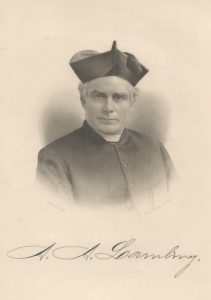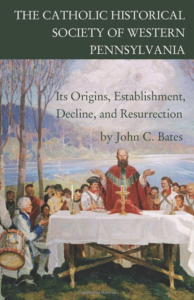
In 1879, Monsignor Andrew Arnold Lambing (1842–1918) laid the groundwork for the Catholic Historical Society of Western Pennsylvania (the “Society”) when, as historian of the Diocese of Pittsburgh, he established a short-lived historical organization called the Ohio Valley Catholic Historical Society.
Sixty-one years would pass before his concept was revived with the formation of such a Catholic organization in 1940.
Anticipation of the 1943 centenary of the Diocese of Pittsburgh served as the impetus for a meeting to establish a Catholic Historical Society of Western Pennsylvania — held on May 27, 1940, at Saint Vincent College in Latrobe. Eight persons were present: Rev. Felix Fellner, O.S.B. (professor at Saint Vincent College, and former President of the American Catholic Historical Association), Rev. Hugh Wilt, O.S.B. (professor of history at Saint Vincent College), Rev. William J. Purcell (professor of history at Mount Mercy College), Joseph A. Beck (Pittsburgh attorney), Paul G. Sullivan (Pittsburgh attorney), Michael H. Kennedy (a staff member of the Pittsburgh Catholic), Alice Thurston McGirr (Carnegie Library of Pittsburgh reference librarian and Head of the Reference Department), and Elizabeth Daflinger (associate editor of The Pittsburgh Catholic).
The founders then held an initial public meeting on July 8 at Mount Mercy College, with more than 500 people in attendance. Bishop Hugh C. Boyle presided. Bylaws were approved, using the name “Catholic Historical Society of Western Pennsylvania.” The Society’s purposes were four-fold:
- To further the study of American Catholic history, especially in Western Pennsylvania
- To gather and correlate papers, documents and relics of our Catholic heritage
- To investigate and research in this field
- To publish the result thereof from time to time
Meetings were held quarterly and at each, and lectures were presented on Western Pennsylvania Catholic history. For the first 14 years, the Society relied completely on the rich local wealth of historians, archivists, and professors to serve as speakers. Historical tours were inaugurated in 1941, along with historical essay contests in diocesan schools. Talks about Catholic history were given on local radio stations WWSW and WJAS. Weekly history columns were printed in The Pittsburgh Catholic.
The Society’s efforts were devoted to the research and writing of a history of the Diocese of Pittsburgh for its 1943 centenary: a volume reflecting the contributions of a symposium of writers. The history was completed for distribution at the Centennial Mass held on October 25, at which the Society’s president, Father Campbell, preached the sermon. The 271-page book, entitled Catholic Pittsburgh’s One Hundred Years 1843-1943, was the modern successor to Monsignor Lambing’s two earlier published histories of the diocese.
Following the ceremony, the memorial gift of the Catholic Historical Society of Western Pennsylvania — a bronze plaque commemorating the six bishops of Pittsburgh who served during the first century of the diocese’s history — was installed in the Chancery (Synod Hall) adjacent to St. Paul’s Cathedral.
In August 1949, the Society reached an arrangement whereby Duquesne University would provide space in its library for the Archives of the Catholic Historical Society of Western Pennsylvania. Coadjutor Bishop John F. Dearden formally dedicated the Society’s Archives Room in the library on October 8, 1950.
The Society then initiated the microfilming of all issues of The Pittsburgh Catholic. The work represented a tri-partite agreement among the Society, Duquesne University officials, and the newspaper. The microfilming was the first ever for an American diocesan newspaper. This visionary step preserved the history of the Catholic Church in Western Pennsylvania as it was recorded in print each year since 1844. In 2008, digitization of the microfilmed newspaper was begun, putting that history on the Internet and making it keyword searchable.
On November 1, 1950, just hours after Pope Pius XII proclaimed the doctrine of the Assumption of the Blessed Virgin Mary as an article of faith, the Society rededicated the statue of the Blessed Virgin on the parapet of St. Mary’s at “The Point” under the title of the Assumption — commemorating the historic fact that Fort Duquesne’s chapel had been erected in 1754 under the title “The Assumption of the Blessed Virgin Mary at the Beautiful River.”
The Society observed the 200th anniversary of the first Mass at Pittsburgh’s “Golden Triangle” celebrated in April 1754 by the chaplain of the French forces at Fort Duquesne, Fr. Denys Baron, with: (1) an academic convocation in Synod Hall with lecture by Father John LaFarge, S.J., associate editor of America, (2) presentation of an original oil painting of the First Mass at Fort Duquesne (sketched by George Sotter, from which his associate Forrest Crooks made a charcoal enlargement, and Charles Hargens did the painting), and (3) reprinting of Monsignor Lambing’s 1885 publication of his translation of The Baptismal Register of Fort Duquesne, penned by the chaplain at Fort Duquesne.
In observance of the bicentennial of the City of Pittsburgh, the Society published a booklet in 1959 entitled From the Point to the Present, to evidence the growth of Catholicity in western Pennsylvania.
Deaths and retirements of the original Society officers ushered in a period of dormancy in the 1960s. But in 1984, Father Bernard L. Hrico (working with Monsignor Francis A. Glenn) resurrected the Society. The Society then embarked on an Oral History project, provided speakers on the history of Catholicism in Western Pennsylvania for parish gatherings, introduced a writing contest for students, expanded its lecture series, resumed tours, and co-sponsored historical lectures with other organizations.
In 1986, the Society commenced issuance of a bi-annual newsletter, Gathered Fragments. The name selected for the publication reflected Monsignor Lambing’s statement about the preservation of local Catholic history, based on the Gospel of St. John: “Gather up the fragments that remain, lest they be lost.” By 2009, the Society’s Gathered Fragments assumed a color glossy journal format; the annual journal now approaches 100 pages per issue.
In 1993, the Board of Directors undertook incorporation to provide a formal legal existence for the Society — which is a non-profit corporation under Section 501(c)(3) of the Internal Revenue Code, and as listed by the Diocese of Pittsburgh in The Official Catholic Directory (P. J. Kenedy & Sons).

In November 2020, board member emeritus John C. Bates completed a comprehensive history of the Society. You can purchase a copy of The Catholic Historical Society of Western Pennsylvania: Its Origins, Establishment, Decline, and Resurrection on Amazon.